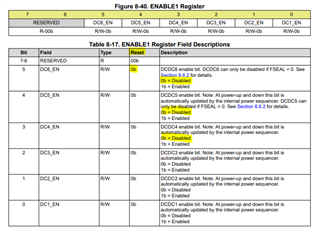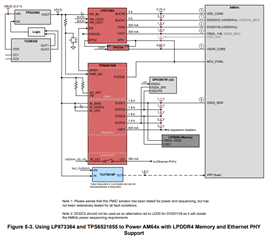Other Parts Discussed in Thread: TPS65218, TPS6521855
Hi Brenda,
It is about PMIC TPS6521815 In system Programming.
The MAIN question is: Is it possible to program/re-program the TPS6521815 with PWR_EN set LOW?
For our design it is CRITICAL to have the answer to this question.
On our prototype design, the DCDC1-4 & LDOs & LOAD SWITCHES must be OFF when the PMIC is re-programmed in order to protect the microprocessor (AM64xx).
The OFF condition of the mentioned voltage outputs is reached when PWR_EN is LOW (which turn-off the inputs of the mentioned above).
We would like to have the possibility to re-program the PMIC on our prototype boards, and with the info we have so far it looks like this is not possible.
Details:
I read your statements regarding this subject, as displayed below:
1) “Only TPS6521815 (blank EEPROM spin) can be re-programmed on-board.
For all other TPS65218x variants you would need to reprogram the device using the booster pack (or a TI distributor like Arrow Services) before soldering the PMIC into the board. The reason is because having the enable signal low will disable the rails but it can also take the PMIC to the OFF state where I2C is not available. “
2) “However, the PWR_EN signal would need to be high otherwise the PMIC will fall info the OFF state where I2C is not available.”
If check in the datasheet for TPS65218 (SLDS206E, Revised Feb 2021) and in the one for TPS6521815 (SLDS261A- Revised Feb 2021) the “Device Functional Modes” – Modes of Operation, there is no difference. As shows below, I2C is ON when PWR_EN is High. And it is recommended to program the PMIC when is in the ACTIVE state, right?
Thanks in advance for your support!
Kind regards,
Niculina




